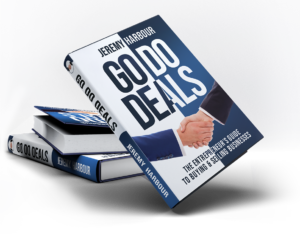We’ve looked at how you might structure a deal with a deal pie, so now let’s have a look at mergers. A merger is an acquisition of a company using shares instead of cash. Instead of paying cash to complete the contract, you give up equity in your business.
It’s absolutely a no-money-down transaction. You give up equity in your business and gain another business.
Why Do a Merger?
Why would you do a merger if all that happens is you double in size, but you end up with half the company? Isn’t that standing still? Well, no, and I’ll give you a few killer reasons why you should look at doing a merger.
Reason 1: Synergies
This reason isn’t my favorite, but it seems to be everyone else’s favorite, so I’ll addresses it first. Synergies are the opportunities for cross-selling things that are duplicated between the two companies. So effectively, you might have two offices, two accounting departments, two of everything, and maybe you only need one of everything, or one and a half of everything. Synergies can add money straight to the bottom line, and money straight to the bottom line goes straight to your valuation because most companies’ value is justified by a multiple of their profits. This has a positive impact on the overall shareholder value.
Why don’t I like the synergies option: In my experience, if you focus on delivering all those synergies, what tends to happen is the business goes down a little in the short term. You might get some benefits from those synergies over a two- to three-year time horizon, but in the short term, you tend to disrupt the business quite a bit. People always look at synergies as being really simple to execute, but they’re actually a real pain and require an awful lot of management time. I prefer to spend my time as a shareholder rather than as an on-the-ground operator.
Reason 2: Best Practice

Best practice is looking at two similar companies and seeing how they arrive at their results. Company X and Company Y could have $1 million gross annual revenue with $100,000 profit, but how they get from their $1 million top line to their $100,000 bottom line might be very different. Some companies might be operationally strong, while others might be strong in sales and marketing. Best practice is about finding the best versions between those two. Using the great sales and marketing of one coupled with the great operational delivery of the other means that you can get this “two plus two equals six” effect when you put the two companies together.
Reason 3: Quick Scale with No Cash
This is where it gets really interesting. You get a quick scale with no cash. In business, big is beautiful. When you become bigger, you get on the radar of many more potential buyers, and it is easier to win bigger contracts and grow. So, by making your business bigger, you’re immediately more attractive. In fact, if you go over the $5 million revenue mark, you tend to arrive on the radar of a number of acquirers within your trade just because at that level, it’s worth their spending the money on the due diligence to buy you, as you’re going to have a meaningful impact on the growth of their business.
Reason 4: Succession Planning
It’s always best to have your succession plan in place well before you’re going to sell your business. You want to sell it with a management team in place, and you want to be a shareholder, not an owner/manager and not an owner/operator.
One of the best uses of the merger structure is for succession planning, and here’s why. Succession planning is a massive pain because the problem with selling a business is that you effectively have to sell yourself with the business. You are one of the operationally important people in the business and will end up being tied to it by some kind of earn-out golden handcuffs, consultancy agreement, whatever.
Now, the problem with succession planning is that you have to go out and recruit somebody to take your place, and recruiting somebody can be a minefield; after all, they may or may not be good at the job. You don’t want someone too entrepreneurial; you want someone who will just sail the ship. But the problem with employees is they’re never as devoted to the company as an owner/manager.
You also tend to damage your profitability by hiring someone to replace you because entrepreneurial CEOs who own the business tend to do it as much for the love and the passion they have for the business as they do for the monetary side. They tend to be massively underpaid for the value that they’re delivering. As soon as you have to pay somebody of the same caliber to do the same thing, it will impact the overall profitability of the business and, therefore, make the business worth a little bit less when it comes to selling it.
Now, if you want to find somebody who’s good at running a business that looks like yours, they’re probably already running a business that looks like yours right now. So, in essence, you want to find a management team in a business that looks like yours and merge with them. And as part of that merger, you take on their management team.
And the great thing is, they’ll want the job.
How to Double Your Business Tomorrow
You can find a merger partner, put the two companies together, and be twice the size. You do this with a newly-created SPV (Special Purpose Vehicle)—the company that you use to do the transaction. This effectively becomes the holding company for the two companies that you want to merge.

Then each of the two companies simply swap their shares into the holding company and the holding company’s capital table, or its share register, becomes the mixture of the shareholders from the two entities that you’re merging. The percentage that you merge them at is, of course, entirely up to you; you can merge based on any valuation or metric that you choose.
I once approached the merger conversation by asking someone how much their business was worth. He said $1 million, which is a common answer to that question. I asked him how he came up with a million dollars. His reasoning was, “We’re making $100,000 a year of profit, so ten times $100,000 is a million.”
I said, “Brilliant, I’m making $50,000 a year of profit, so ten times $50,000 is $500,000, so I’ll have a third and you have two thirds.” He couldn’t argue with his own logic. He came up with the valuation model, and it actually happened to suit me particularly well because we were much, much smaller than he was, and so I was happy to take his metric.
You can value a business by gross annual revenue, number of subscribers, gross profit, net profit, or net asset value on the balance sheet. You can use pretty much whatever metric you choose as a valuation method.
There are no rules. The wonderful thing about business is that you can be as creative as you like in how you structure these deals. It’s easy to come up with a million different ways to make it really interesting.
Next time, I’m going to share about a great tactic to take a sweat equity stake in a business and then sell it back to the founder. I found this quite by accident. You’ll want to learn more about it.
Let’s Connect!
HarbourClubUSA.com
Unity-Group.com



